BUS5SMM: Tengri's Sustainable Marketing Strategy Case Study
VerifiedAdded on 2024/04/17
|15
|3453
|170
Case Study
AI Summary
This report provides an in-depth analysis of Tengri, a London-based clothing, accessories, and homeware brand, and its sustainable marketing practices. It examines Tengri's business model, which centers around sourcing fabric from Mongolian Yak through partnerships with regional Mongolian communities, and its commitment to integrating sustainability into the textile industry. The report focuses on the application of the marketing mix elements within Tengri's competitive business environment, highlighting the company's dedication to ethical sourcing, transparent supply chains, and profit-sharing with herders, designers, and manufacturers. It also analyzes Tengri's positioning in the market, emphasizing its strengths in sustainability and ethical practices compared to competitors, and discusses the company's fair-share model and other sustainable marketing principles. The report concludes by underscoring Tengri's commitment to social engagement, waste reduction, and longevity in its business operations.

BUS5SMM: ASSESSMENT TASK 2
1
1
Paraphrase This Document
Need a fresh take? Get an instant paraphrase of this document with our AI Paraphraser
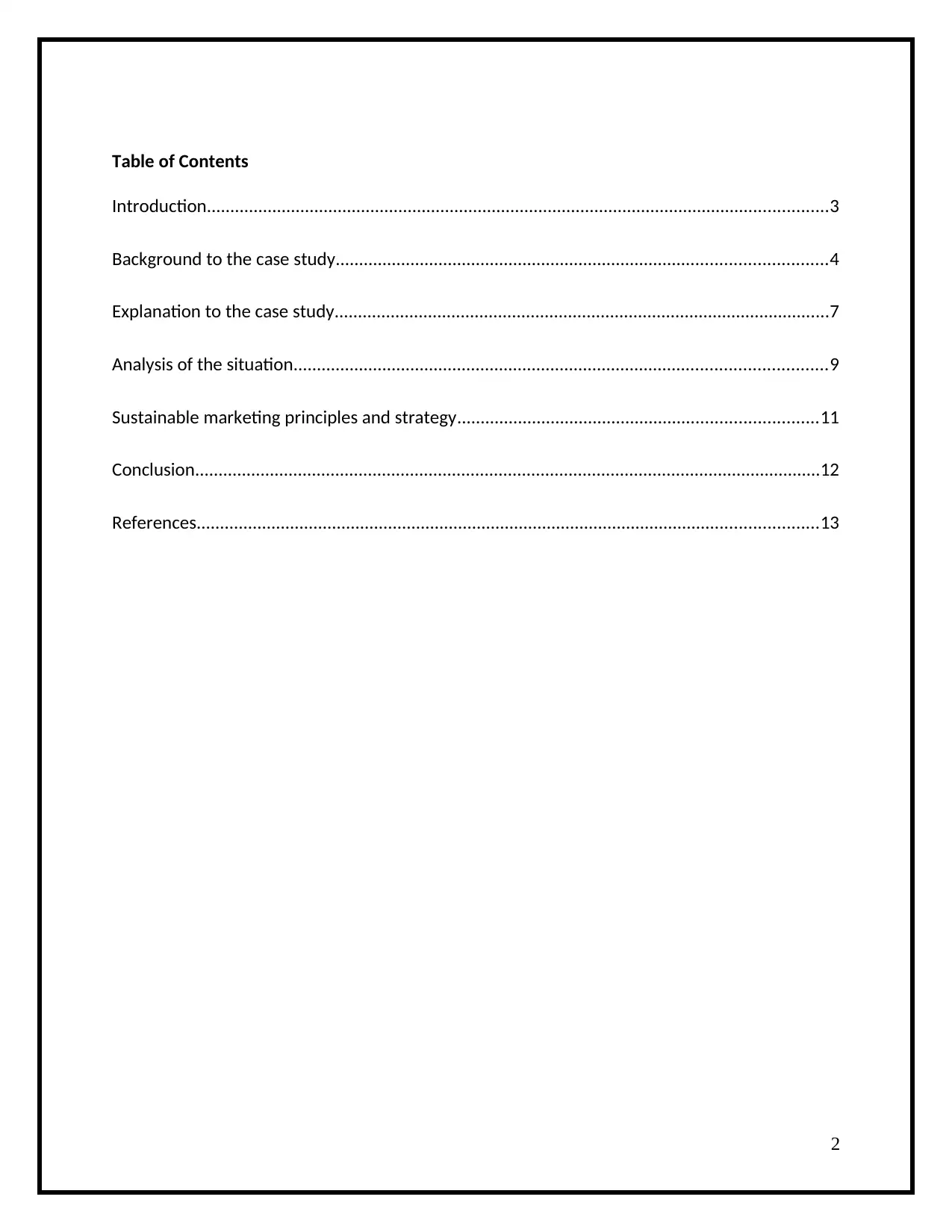
Table of Contents
Introduction.....................................................................................................................................3
Background to the case study.........................................................................................................4
Explanation to the case study..........................................................................................................7
Analysis of the situation..................................................................................................................9
Sustainable marketing principles and strategy.............................................................................11
Conclusion......................................................................................................................................12
References.....................................................................................................................................13
2
Introduction.....................................................................................................................................3
Background to the case study.........................................................................................................4
Explanation to the case study..........................................................................................................7
Analysis of the situation..................................................................................................................9
Sustainable marketing principles and strategy.............................................................................11
Conclusion......................................................................................................................................12
References.....................................................................................................................................13
2
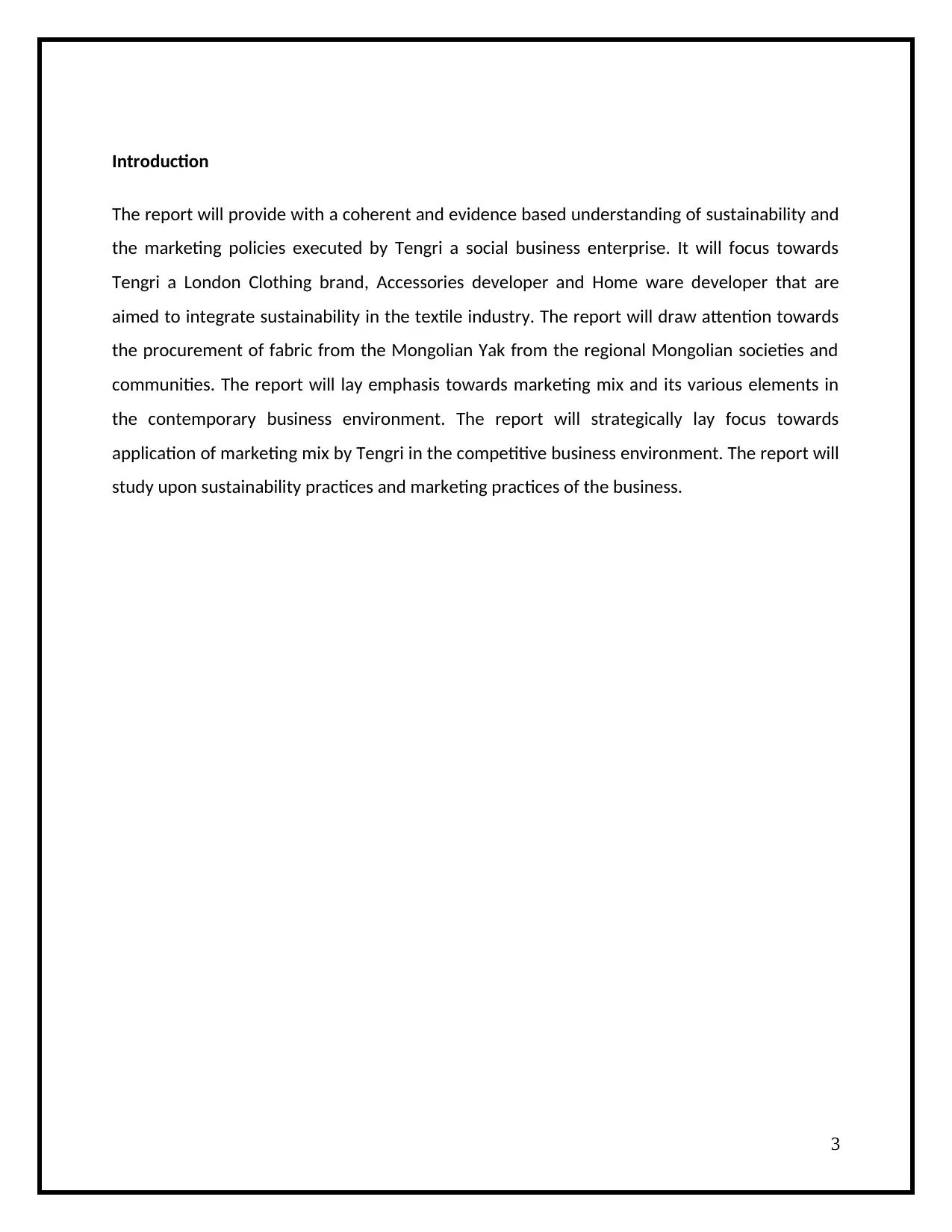
Introduction
The report will provide with a coherent and evidence based understanding of sustainability and
the marketing policies executed by Tengri a social business enterprise. It will focus towards
Tengri a London Clothing brand, Accessories developer and Home ware developer that are
aimed to integrate sustainability in the textile industry. The report will draw attention towards
the procurement of fabric from the Mongolian Yak from the regional Mongolian societies and
communities. The report will lay emphasis towards marketing mix and its various elements in
the contemporary business environment. The report will strategically lay focus towards
application of marketing mix by Tengri in the competitive business environment. The report will
study upon sustainability practices and marketing practices of the business.
3
The report will provide with a coherent and evidence based understanding of sustainability and
the marketing policies executed by Tengri a social business enterprise. It will focus towards
Tengri a London Clothing brand, Accessories developer and Home ware developer that are
aimed to integrate sustainability in the textile industry. The report will draw attention towards
the procurement of fabric from the Mongolian Yak from the regional Mongolian societies and
communities. The report will lay emphasis towards marketing mix and its various elements in
the contemporary business environment. The report will strategically lay focus towards
application of marketing mix by Tengri in the competitive business environment. The report will
study upon sustainability practices and marketing practices of the business.
3
⊘ This is a preview!⊘
Do you want full access?
Subscribe today to unlock all pages.

Trusted by 1+ million students worldwide
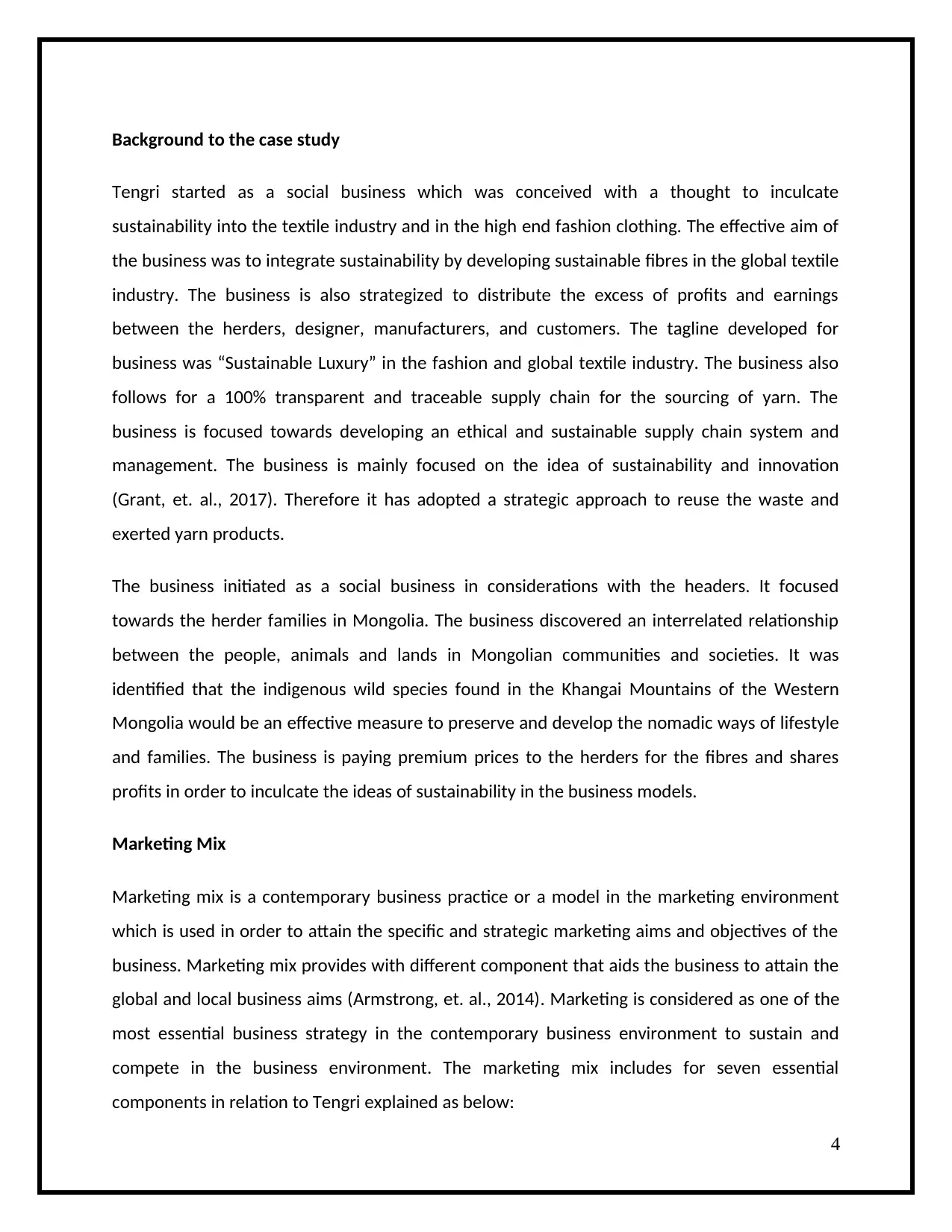
Background to the case study
Tengri started as a social business which was conceived with a thought to inculcate
sustainability into the textile industry and in the high end fashion clothing. The effective aim of
the business was to integrate sustainability by developing sustainable fibres in the global textile
industry. The business is also strategized to distribute the excess of profits and earnings
between the herders, designer, manufacturers, and customers. The tagline developed for
business was “Sustainable Luxury” in the fashion and global textile industry. The business also
follows for a 100% transparent and traceable supply chain for the sourcing of yarn. The
business is focused towards developing an ethical and sustainable supply chain system and
management. The business is mainly focused on the idea of sustainability and innovation
(Grant, et. al., 2017). Therefore it has adopted a strategic approach to reuse the waste and
exerted yarn products.
The business initiated as a social business in considerations with the headers. It focused
towards the herder families in Mongolia. The business discovered an interrelated relationship
between the people, animals and lands in Mongolian communities and societies. It was
identified that the indigenous wild species found in the Khangai Mountains of the Western
Mongolia would be an effective measure to preserve and develop the nomadic ways of lifestyle
and families. The business is paying premium prices to the herders for the fibres and shares
profits in order to inculcate the ideas of sustainability in the business models.
Marketing Mix
Marketing mix is a contemporary business practice or a model in the marketing environment
which is used in order to attain the specific and strategic marketing aims and objectives of the
business. Marketing mix provides with different component that aids the business to attain the
global and local business aims (Armstrong, et. al., 2014). Marketing is considered as one of the
most essential business strategy in the contemporary business environment to sustain and
compete in the business environment. The marketing mix includes for seven essential
components in relation to Tengri explained as below:
4
Tengri started as a social business which was conceived with a thought to inculcate
sustainability into the textile industry and in the high end fashion clothing. The effective aim of
the business was to integrate sustainability by developing sustainable fibres in the global textile
industry. The business is also strategized to distribute the excess of profits and earnings
between the herders, designer, manufacturers, and customers. The tagline developed for
business was “Sustainable Luxury” in the fashion and global textile industry. The business also
follows for a 100% transparent and traceable supply chain for the sourcing of yarn. The
business is focused towards developing an ethical and sustainable supply chain system and
management. The business is mainly focused on the idea of sustainability and innovation
(Grant, et. al., 2017). Therefore it has adopted a strategic approach to reuse the waste and
exerted yarn products.
The business initiated as a social business in considerations with the headers. It focused
towards the herder families in Mongolia. The business discovered an interrelated relationship
between the people, animals and lands in Mongolian communities and societies. It was
identified that the indigenous wild species found in the Khangai Mountains of the Western
Mongolia would be an effective measure to preserve and develop the nomadic ways of lifestyle
and families. The business is paying premium prices to the herders for the fibres and shares
profits in order to inculcate the ideas of sustainability in the business models.
Marketing Mix
Marketing mix is a contemporary business practice or a model in the marketing environment
which is used in order to attain the specific and strategic marketing aims and objectives of the
business. Marketing mix provides with different component that aids the business to attain the
global and local business aims (Armstrong, et. al., 2014). Marketing is considered as one of the
most essential business strategy in the contemporary business environment to sustain and
compete in the business environment. The marketing mix includes for seven essential
components in relation to Tengri explained as below:
4
Paraphrase This Document
Need a fresh take? Get an instant paraphrase of this document with our AI Paraphraser
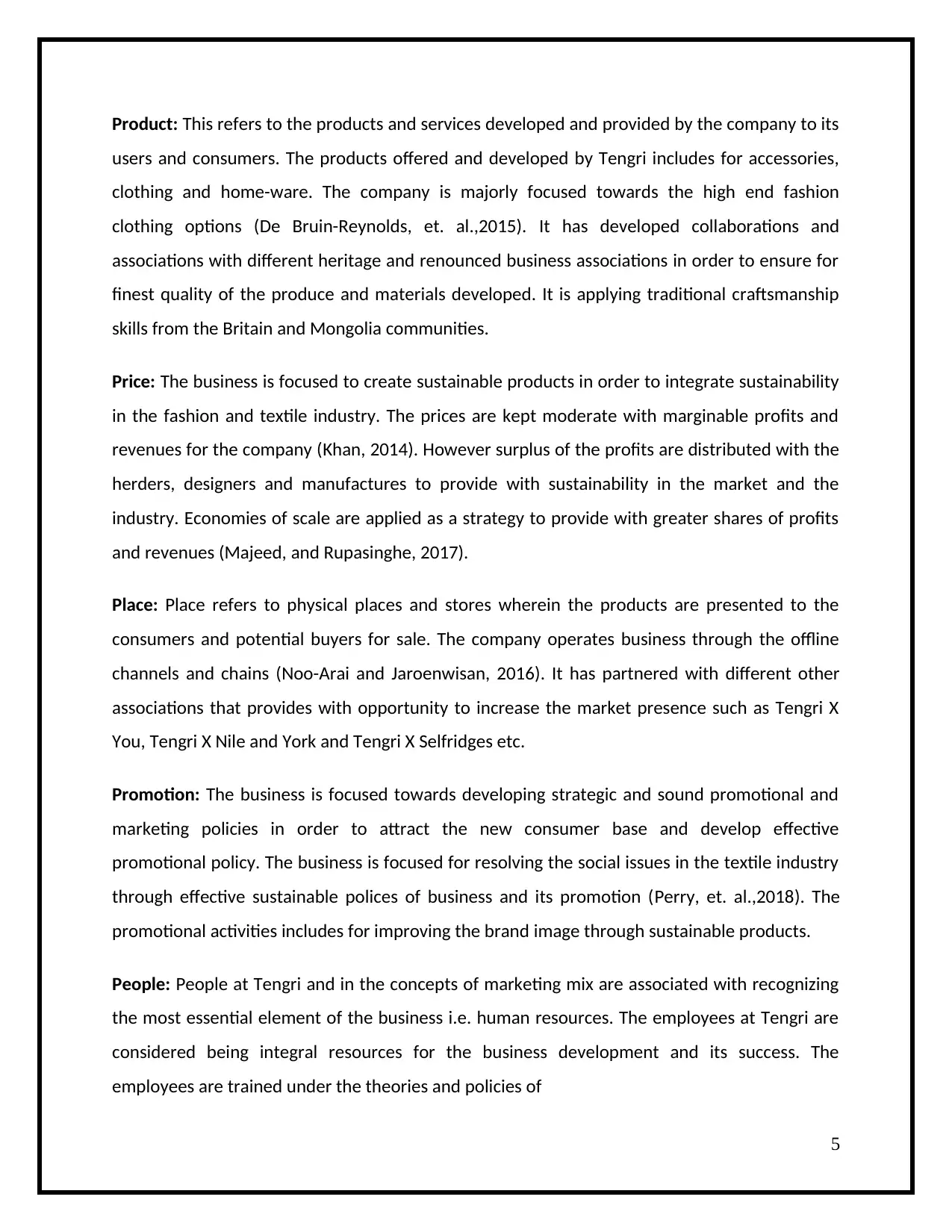
Product: This refers to the products and services developed and provided by the company to its
users and consumers. The products offered and developed by Tengri includes for accessories,
clothing and home-ware. The company is majorly focused towards the high end fashion
clothing options (De Bruin-Reynolds, et. al.,2015). It has developed collaborations and
associations with different heritage and renounced business associations in order to ensure for
finest quality of the produce and materials developed. It is applying traditional craftsmanship
skills from the Britain and Mongolia communities.
Price: The business is focused to create sustainable products in order to integrate sustainability
in the fashion and textile industry. The prices are kept moderate with marginable profits and
revenues for the company (Khan, 2014). However surplus of the profits are distributed with the
herders, designers and manufactures to provide with sustainability in the market and the
industry. Economies of scale are applied as a strategy to provide with greater shares of profits
and revenues (Majeed, and Rupasinghe, 2017).
Place: Place refers to physical places and stores wherein the products are presented to the
consumers and potential buyers for sale. The company operates business through the offline
channels and chains (Noo-Arai and Jaroenwisan, 2016). It has partnered with different other
associations that provides with opportunity to increase the market presence such as Tengri X
You, Tengri X Nile and York and Tengri X Selfridges etc.
Promotion: The business is focused towards developing strategic and sound promotional and
marketing policies in order to attract the new consumer base and develop effective
promotional policy. The business is focused for resolving the social issues in the textile industry
through effective sustainable polices of business and its promotion (Perry, et. al.,2018). The
promotional activities includes for improving the brand image through sustainable products.
People: People at Tengri and in the concepts of marketing mix are associated with recognizing
the most essential element of the business i.e. human resources. The employees at Tengri are
considered being integral resources for the business development and its success. The
employees are trained under the theories and policies of
5
users and consumers. The products offered and developed by Tengri includes for accessories,
clothing and home-ware. The company is majorly focused towards the high end fashion
clothing options (De Bruin-Reynolds, et. al.,2015). It has developed collaborations and
associations with different heritage and renounced business associations in order to ensure for
finest quality of the produce and materials developed. It is applying traditional craftsmanship
skills from the Britain and Mongolia communities.
Price: The business is focused to create sustainable products in order to integrate sustainability
in the fashion and textile industry. The prices are kept moderate with marginable profits and
revenues for the company (Khan, 2014). However surplus of the profits are distributed with the
herders, designers and manufactures to provide with sustainability in the market and the
industry. Economies of scale are applied as a strategy to provide with greater shares of profits
and revenues (Majeed, and Rupasinghe, 2017).
Place: Place refers to physical places and stores wherein the products are presented to the
consumers and potential buyers for sale. The company operates business through the offline
channels and chains (Noo-Arai and Jaroenwisan, 2016). It has partnered with different other
associations that provides with opportunity to increase the market presence such as Tengri X
You, Tengri X Nile and York and Tengri X Selfridges etc.
Promotion: The business is focused towards developing strategic and sound promotional and
marketing policies in order to attract the new consumer base and develop effective
promotional policy. The business is focused for resolving the social issues in the textile industry
through effective sustainable polices of business and its promotion (Perry, et. al.,2018). The
promotional activities includes for improving the brand image through sustainable products.
People: People at Tengri and in the concepts of marketing mix are associated with recognizing
the most essential element of the business i.e. human resources. The employees at Tengri are
considered being integral resources for the business development and its success. The
employees are trained under the theories and policies of
5
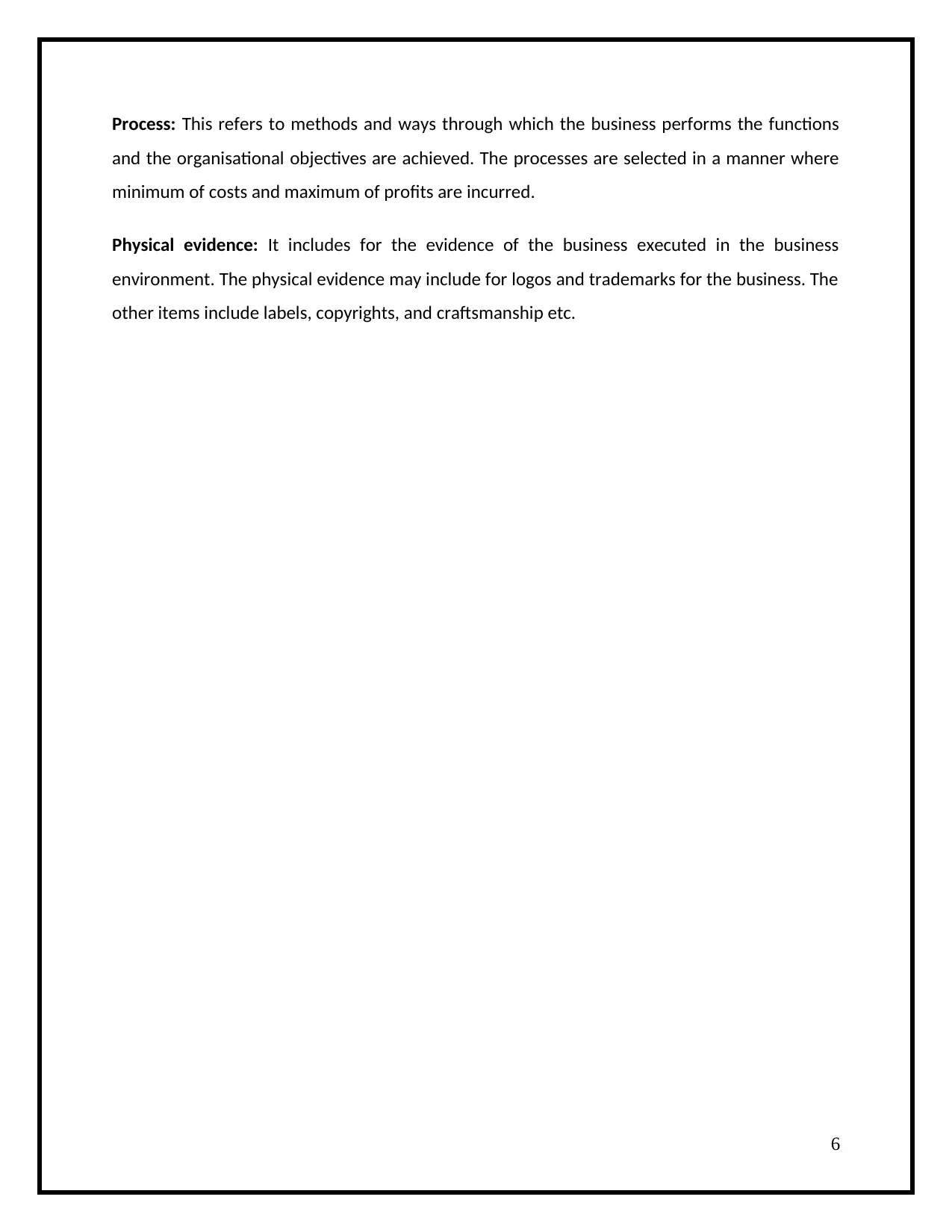
Process: This refers to methods and ways through which the business performs the functions
and the organisational objectives are achieved. The processes are selected in a manner where
minimum of costs and maximum of profits are incurred.
Physical evidence: It includes for the evidence of the business executed in the business
environment. The physical evidence may include for logos and trademarks for the business. The
other items include labels, copyrights, and craftsmanship etc.
6
and the organisational objectives are achieved. The processes are selected in a manner where
minimum of costs and maximum of profits are incurred.
Physical evidence: It includes for the evidence of the business executed in the business
environment. The physical evidence may include for logos and trademarks for the business. The
other items include labels, copyrights, and craftsmanship etc.
6
⊘ This is a preview!⊘
Do you want full access?
Subscribe today to unlock all pages.

Trusted by 1+ million students worldwide
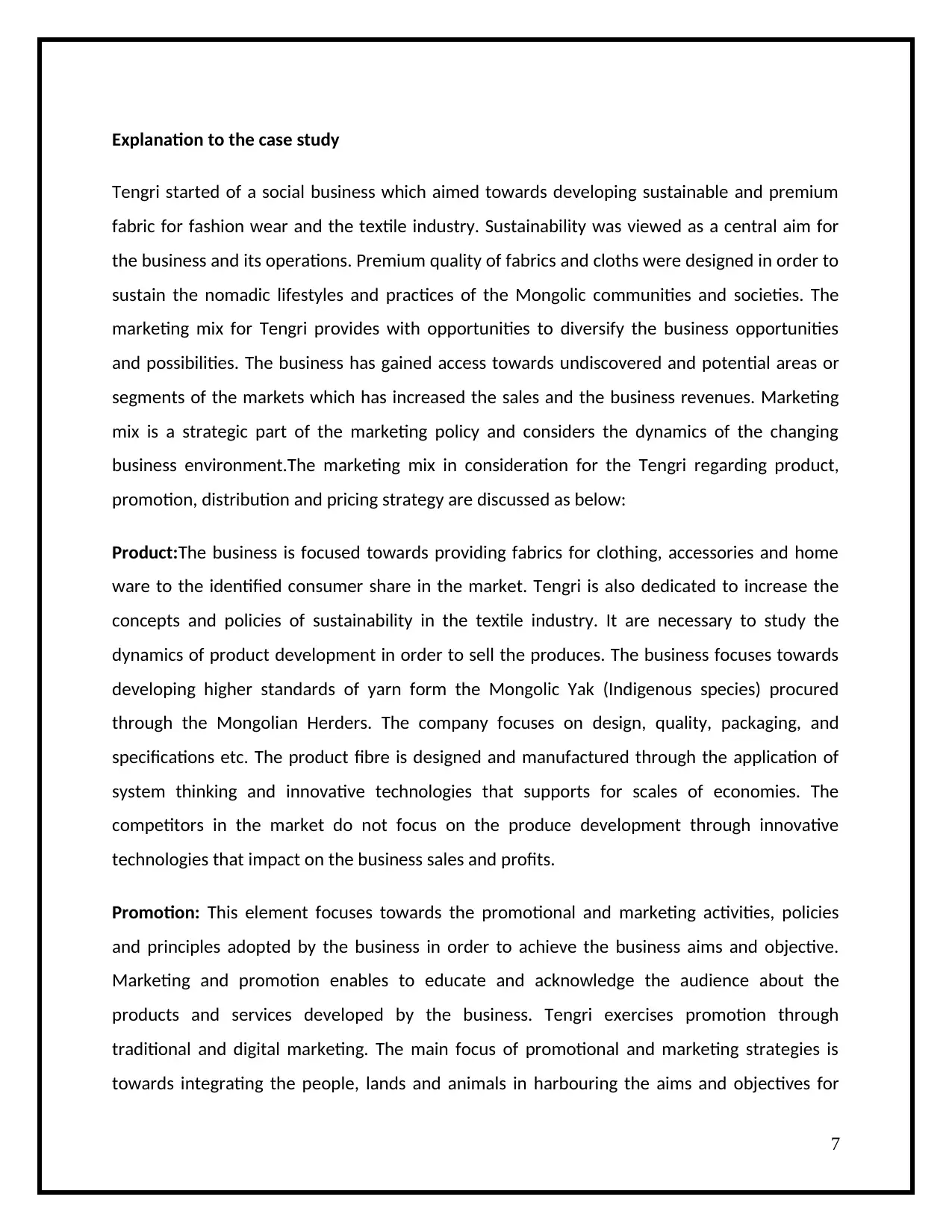
Explanation to the case study
Tengri started of a social business which aimed towards developing sustainable and premium
fabric for fashion wear and the textile industry. Sustainability was viewed as a central aim for
the business and its operations. Premium quality of fabrics and cloths were designed in order to
sustain the nomadic lifestyles and practices of the Mongolic communities and societies. The
marketing mix for Tengri provides with opportunities to diversify the business opportunities
and possibilities. The business has gained access towards undiscovered and potential areas or
segments of the markets which has increased the sales and the business revenues. Marketing
mix is a strategic part of the marketing policy and considers the dynamics of the changing
business environment.The marketing mix in consideration for the Tengri regarding product,
promotion, distribution and pricing strategy are discussed as below:
Product:The business is focused towards providing fabrics for clothing, accessories and home
ware to the identified consumer share in the market. Tengri is also dedicated to increase the
concepts and policies of sustainability in the textile industry. It are necessary to study the
dynamics of product development in order to sell the produces. The business focuses towards
developing higher standards of yarn form the Mongolic Yak (Indigenous species) procured
through the Mongolian Herders. The company focuses on design, quality, packaging, and
specifications etc. The product fibre is designed and manufactured through the application of
system thinking and innovative technologies that supports for scales of economies. The
competitors in the market do not focus on the produce development through innovative
technologies that impact on the business sales and profits.
Promotion: This element focuses towards the promotional and marketing activities, policies
and principles adopted by the business in order to achieve the business aims and objective.
Marketing and promotion enables to educate and acknowledge the audience about the
products and services developed by the business. Tengri exercises promotion through
traditional and digital marketing. The main focus of promotional and marketing strategies is
towards integrating the people, lands and animals in harbouring the aims and objectives for
7
Tengri started of a social business which aimed towards developing sustainable and premium
fabric for fashion wear and the textile industry. Sustainability was viewed as a central aim for
the business and its operations. Premium quality of fabrics and cloths were designed in order to
sustain the nomadic lifestyles and practices of the Mongolic communities and societies. The
marketing mix for Tengri provides with opportunities to diversify the business opportunities
and possibilities. The business has gained access towards undiscovered and potential areas or
segments of the markets which has increased the sales and the business revenues. Marketing
mix is a strategic part of the marketing policy and considers the dynamics of the changing
business environment.The marketing mix in consideration for the Tengri regarding product,
promotion, distribution and pricing strategy are discussed as below:
Product:The business is focused towards providing fabrics for clothing, accessories and home
ware to the identified consumer share in the market. Tengri is also dedicated to increase the
concepts and policies of sustainability in the textile industry. It are necessary to study the
dynamics of product development in order to sell the produces. The business focuses towards
developing higher standards of yarn form the Mongolic Yak (Indigenous species) procured
through the Mongolian Herders. The company focuses on design, quality, packaging, and
specifications etc. The product fibre is designed and manufactured through the application of
system thinking and innovative technologies that supports for scales of economies. The
competitors in the market do not focus on the produce development through innovative
technologies that impact on the business sales and profits.
Promotion: This element focuses towards the promotional and marketing activities, policies
and principles adopted by the business in order to achieve the business aims and objective.
Marketing and promotion enables to educate and acknowledge the audience about the
products and services developed by the business. Tengri exercises promotion through
traditional and digital marketing. The main focus of promotional and marketing strategies is
towards integrating the people, lands and animals in harbouring the aims and objectives for
7
Paraphrase This Document
Need a fresh take? Get an instant paraphrase of this document with our AI Paraphraser
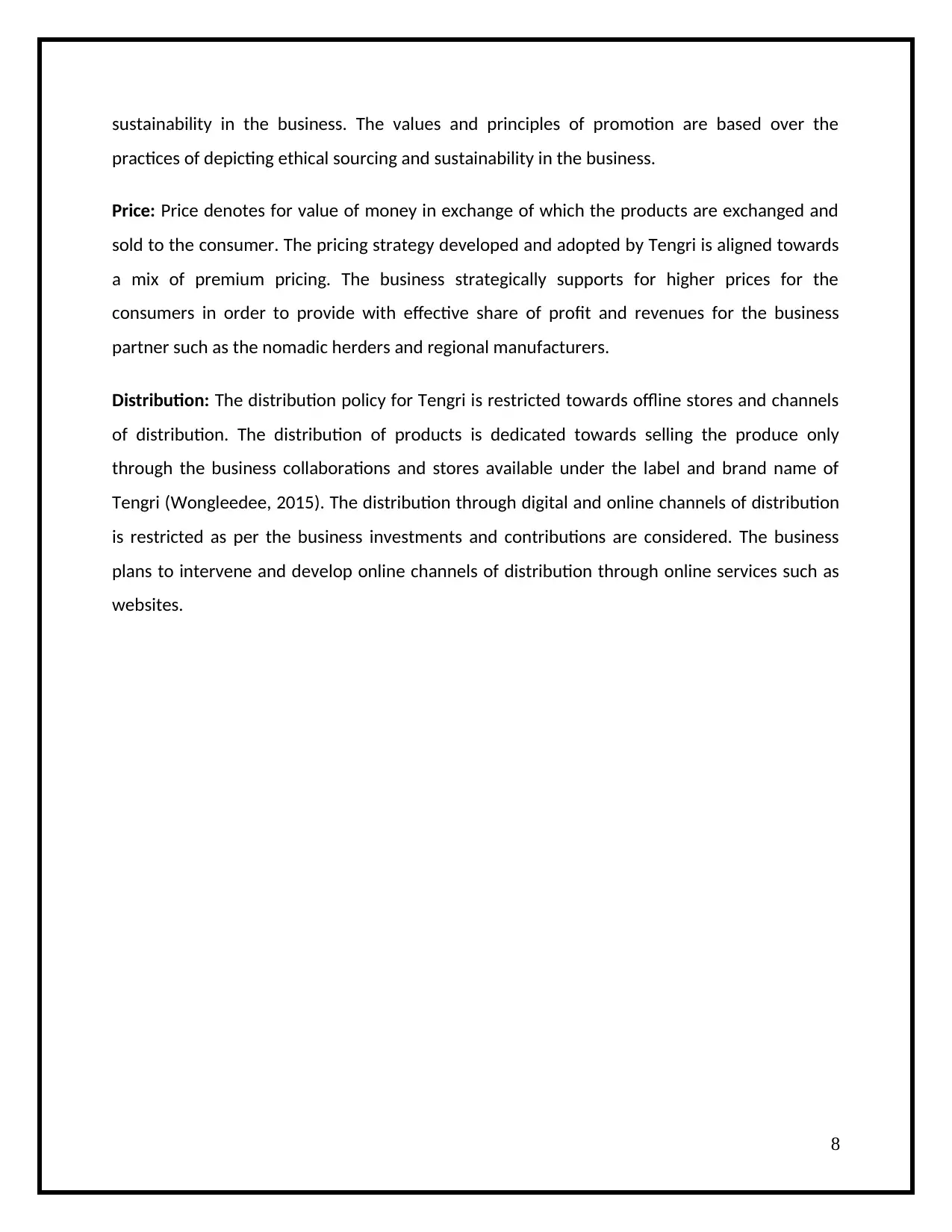
sustainability in the business. The values and principles of promotion are based over the
practices of depicting ethical sourcing and sustainability in the business.
Price: Price denotes for value of money in exchange of which the products are exchanged and
sold to the consumer. The pricing strategy developed and adopted by Tengri is aligned towards
a mix of premium pricing. The business strategically supports for higher prices for the
consumers in order to provide with effective share of profit and revenues for the business
partner such as the nomadic herders and regional manufacturers.
Distribution: The distribution policy for Tengri is restricted towards offline stores and channels
of distribution. The distribution of products is dedicated towards selling the produce only
through the business collaborations and stores available under the label and brand name of
Tengri (Wongleedee, 2015). The distribution through digital and online channels of distribution
is restricted as per the business investments and contributions are considered. The business
plans to intervene and develop online channels of distribution through online services such as
websites.
8
practices of depicting ethical sourcing and sustainability in the business.
Price: Price denotes for value of money in exchange of which the products are exchanged and
sold to the consumer. The pricing strategy developed and adopted by Tengri is aligned towards
a mix of premium pricing. The business strategically supports for higher prices for the
consumers in order to provide with effective share of profit and revenues for the business
partner such as the nomadic herders and regional manufacturers.
Distribution: The distribution policy for Tengri is restricted towards offline stores and channels
of distribution. The distribution of products is dedicated towards selling the produce only
through the business collaborations and stores available under the label and brand name of
Tengri (Wongleedee, 2015). The distribution through digital and online channels of distribution
is restricted as per the business investments and contributions are considered. The business
plans to intervene and develop online channels of distribution through online services such as
websites.
8
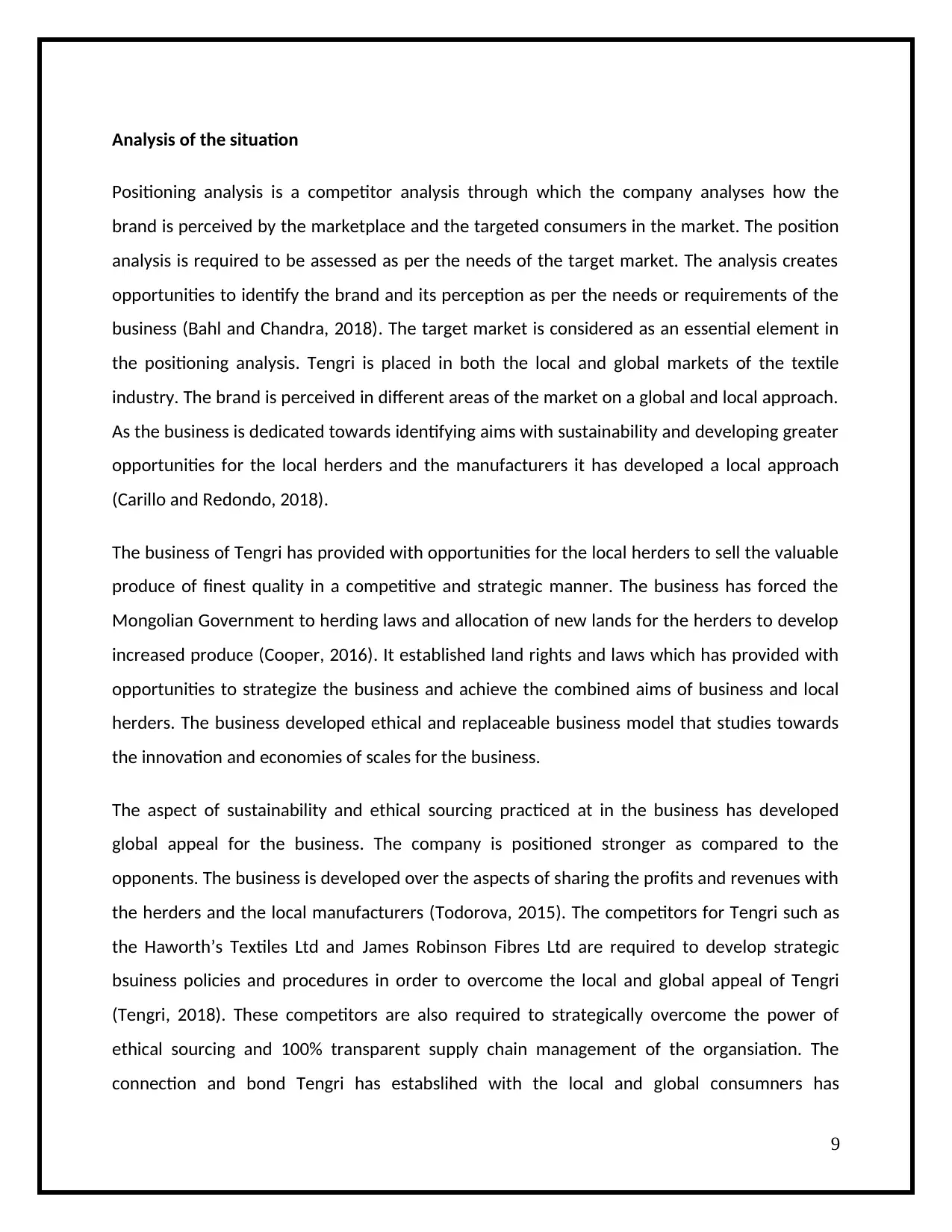
Analysis of the situation
Positioning analysis is a competitor analysis through which the company analyses how the
brand is perceived by the marketplace and the targeted consumers in the market. The position
analysis is required to be assessed as per the needs of the target market. The analysis creates
opportunities to identify the brand and its perception as per the needs or requirements of the
business (Bahl and Chandra, 2018). The target market is considered as an essential element in
the positioning analysis. Tengri is placed in both the local and global markets of the textile
industry. The brand is perceived in different areas of the market on a global and local approach.
As the business is dedicated towards identifying aims with sustainability and developing greater
opportunities for the local herders and the manufacturers it has developed a local approach
(Carillo and Redondo, 2018).
The business of Tengri has provided with opportunities for the local herders to sell the valuable
produce of finest quality in a competitive and strategic manner. The business has forced the
Mongolian Government to herding laws and allocation of new lands for the herders to develop
increased produce (Cooper, 2016). It established land rights and laws which has provided with
opportunities to strategize the business and achieve the combined aims of business and local
herders. The business developed ethical and replaceable business model that studies towards
the innovation and economies of scales for the business.
The aspect of sustainability and ethical sourcing practiced at in the business has developed
global appeal for the business. The company is positioned stronger as compared to the
opponents. The business is developed over the aspects of sharing the profits and revenues with
the herders and the local manufacturers (Todorova, 2015). The competitors for Tengri such as
the Haworth’s Textiles Ltd and James Robinson Fibres Ltd are required to develop strategic
bsuiness policies and procedures in order to overcome the local and global appeal of Tengri
(Tengri, 2018). These competitors are also required to strategically overcome the power of
ethical sourcing and 100% transparent supply chain management of the organsiation. The
connection and bond Tengri has estabslihed with the local and global consumners has
9
Positioning analysis is a competitor analysis through which the company analyses how the
brand is perceived by the marketplace and the targeted consumers in the market. The position
analysis is required to be assessed as per the needs of the target market. The analysis creates
opportunities to identify the brand and its perception as per the needs or requirements of the
business (Bahl and Chandra, 2018). The target market is considered as an essential element in
the positioning analysis. Tengri is placed in both the local and global markets of the textile
industry. The brand is perceived in different areas of the market on a global and local approach.
As the business is dedicated towards identifying aims with sustainability and developing greater
opportunities for the local herders and the manufacturers it has developed a local approach
(Carillo and Redondo, 2018).
The business of Tengri has provided with opportunities for the local herders to sell the valuable
produce of finest quality in a competitive and strategic manner. The business has forced the
Mongolian Government to herding laws and allocation of new lands for the herders to develop
increased produce (Cooper, 2016). It established land rights and laws which has provided with
opportunities to strategize the business and achieve the combined aims of business and local
herders. The business developed ethical and replaceable business model that studies towards
the innovation and economies of scales for the business.
The aspect of sustainability and ethical sourcing practiced at in the business has developed
global appeal for the business. The company is positioned stronger as compared to the
opponents. The business is developed over the aspects of sharing the profits and revenues with
the herders and the local manufacturers (Todorova, 2015). The competitors for Tengri such as
the Haworth’s Textiles Ltd and James Robinson Fibres Ltd are required to develop strategic
bsuiness policies and procedures in order to overcome the local and global appeal of Tengri
(Tengri, 2018). These competitors are also required to strategically overcome the power of
ethical sourcing and 100% transparent supply chain management of the organsiation. The
connection and bond Tengri has estabslihed with the local and global consumners has
9
⊘ This is a preview!⊘
Do you want full access?
Subscribe today to unlock all pages.

Trusted by 1+ million students worldwide
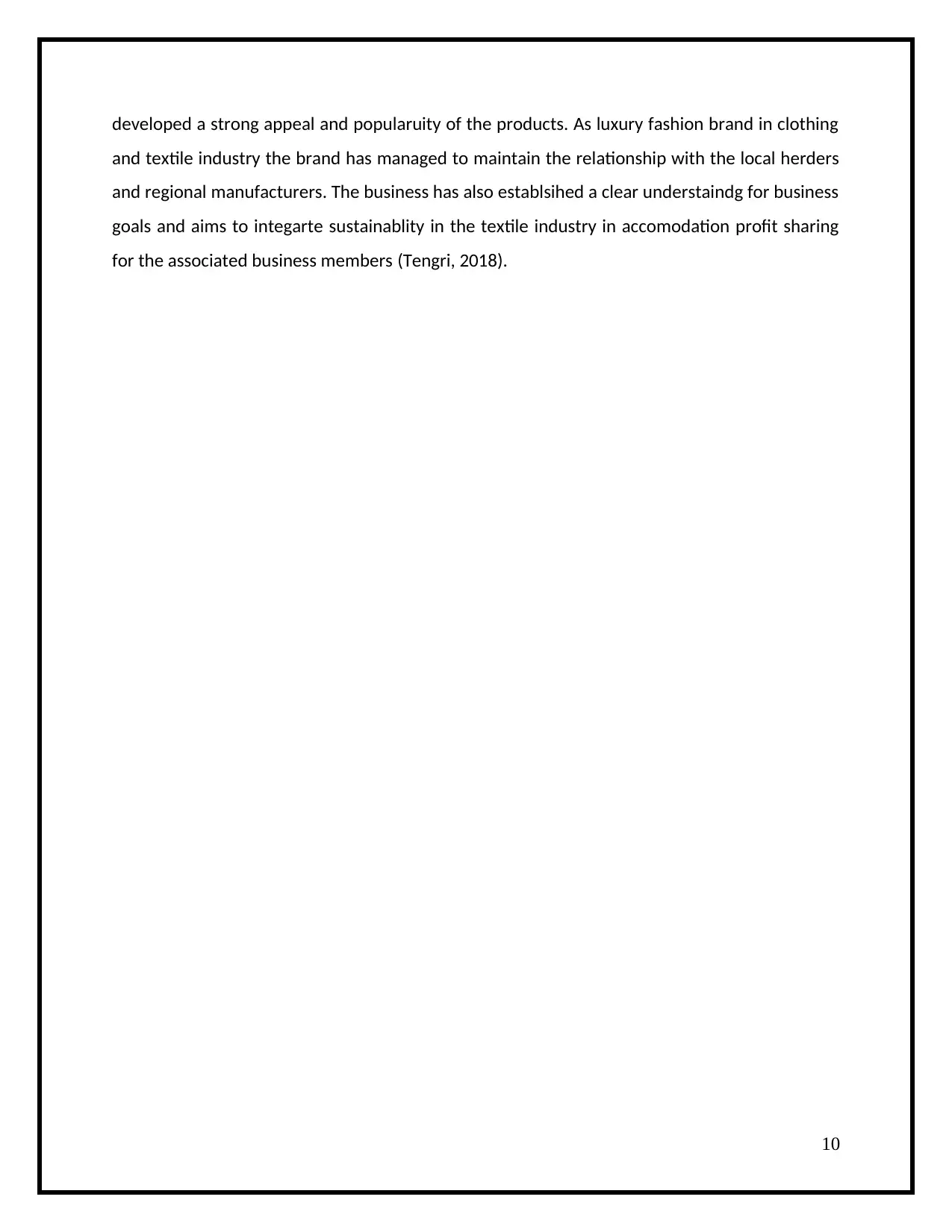
developed a strong appeal and popularuity of the products. As luxury fashion brand in clothing
and textile industry the brand has managed to maintain the relationship with the local herders
and regional manufacturers. The business has also establsihed a clear understaindg for business
goals and aims to integarte sustainablity in the textile industry in accomodation profit sharing
for the associated business members (Tengri, 2018).
10
and textile industry the brand has managed to maintain the relationship with the local herders
and regional manufacturers. The business has also establsihed a clear understaindg for business
goals and aims to integarte sustainablity in the textile industry in accomodation profit sharing
for the associated business members (Tengri, 2018).
10
Paraphrase This Document
Need a fresh take? Get an instant paraphrase of this document with our AI Paraphraser
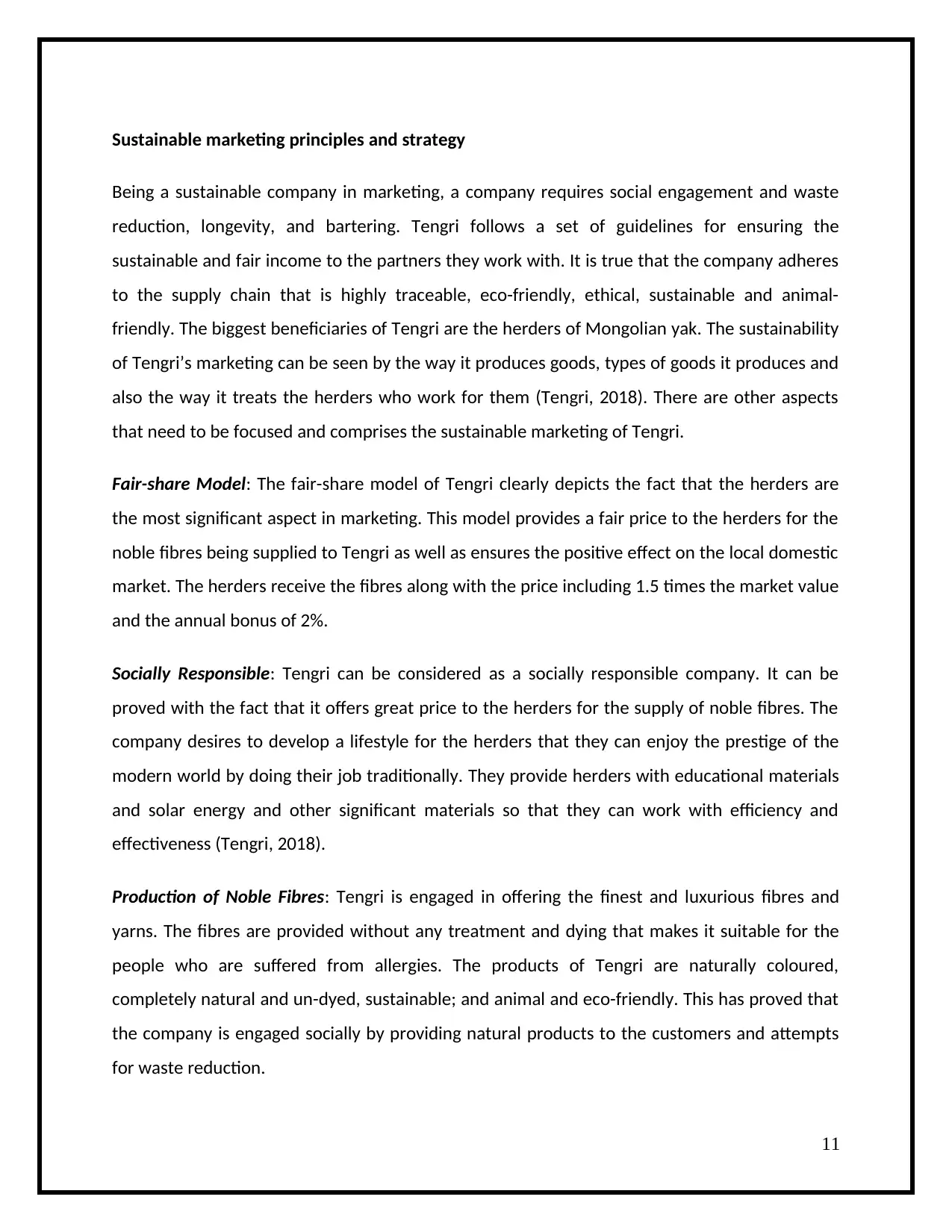
Sustainable marketing principles and strategy
Being a sustainable company in marketing, a company requires social engagement and waste
reduction, longevity, and bartering. Tengri follows a set of guidelines for ensuring the
sustainable and fair income to the partners they work with. It is true that the company adheres
to the supply chain that is highly traceable, eco-friendly, ethical, sustainable and animal-
friendly. The biggest beneficiaries of Tengri are the herders of Mongolian yak. The sustainability
of Tengri’s marketing can be seen by the way it produces goods, types of goods it produces and
also the way it treats the herders who work for them (Tengri, 2018). There are other aspects
that need to be focused and comprises the sustainable marketing of Tengri.
Fair-share Model: The fair-share model of Tengri clearly depicts the fact that the herders are
the most significant aspect in marketing. This model provides a fair price to the herders for the
noble fibres being supplied to Tengri as well as ensures the positive effect on the local domestic
market. The herders receive the fibres along with the price including 1.5 times the market value
and the annual bonus of 2%.
Socially Responsible: Tengri can be considered as a socially responsible company. It can be
proved with the fact that it offers great price to the herders for the supply of noble fibres. The
company desires to develop a lifestyle for the herders that they can enjoy the prestige of the
modern world by doing their job traditionally. They provide herders with educational materials
and solar energy and other significant materials so that they can work with efficiency and
effectiveness (Tengri, 2018).
Production of Noble Fibres: Tengri is engaged in offering the finest and luxurious fibres and
yarns. The fibres are provided without any treatment and dying that makes it suitable for the
people who are suffered from allergies. The products of Tengri are naturally coloured,
completely natural and un-dyed, sustainable; and animal and eco-friendly. This has proved that
the company is engaged socially by providing natural products to the customers and attempts
for waste reduction.
11
Being a sustainable company in marketing, a company requires social engagement and waste
reduction, longevity, and bartering. Tengri follows a set of guidelines for ensuring the
sustainable and fair income to the partners they work with. It is true that the company adheres
to the supply chain that is highly traceable, eco-friendly, ethical, sustainable and animal-
friendly. The biggest beneficiaries of Tengri are the herders of Mongolian yak. The sustainability
of Tengri’s marketing can be seen by the way it produces goods, types of goods it produces and
also the way it treats the herders who work for them (Tengri, 2018). There are other aspects
that need to be focused and comprises the sustainable marketing of Tengri.
Fair-share Model: The fair-share model of Tengri clearly depicts the fact that the herders are
the most significant aspect in marketing. This model provides a fair price to the herders for the
noble fibres being supplied to Tengri as well as ensures the positive effect on the local domestic
market. The herders receive the fibres along with the price including 1.5 times the market value
and the annual bonus of 2%.
Socially Responsible: Tengri can be considered as a socially responsible company. It can be
proved with the fact that it offers great price to the herders for the supply of noble fibres. The
company desires to develop a lifestyle for the herders that they can enjoy the prestige of the
modern world by doing their job traditionally. They provide herders with educational materials
and solar energy and other significant materials so that they can work with efficiency and
effectiveness (Tengri, 2018).
Production of Noble Fibres: Tengri is engaged in offering the finest and luxurious fibres and
yarns. The fibres are provided without any treatment and dying that makes it suitable for the
people who are suffered from allergies. The products of Tengri are naturally coloured,
completely natural and un-dyed, sustainable; and animal and eco-friendly. This has proved that
the company is engaged socially by providing natural products to the customers and attempts
for waste reduction.
11

Preservation of Lands: It should be noted that the climatic changes globally and growing
industrialization has threatened the wildlife as well as the landscapes. Tengri focuses on the
preservation of wildlife and landscapes and works with experts for the purpose of reversing
land degradation. The company has been associated with the experts of conservation and
wildlife, herders’ families and governments to ensure that the company is not harming the
landscape and wildlife while growing and making huge profits (Thomas, 2018). This association
has been developed under the Tengri Nature Conservancy Programme.
Green Partnerships: A fibre named Khangai Yak fibre is completely a new product in the market
which is not only a natural but also a sustainable product. Tengri has adopted advanced
technology for innovative production as well as green technologies so that the fibre can be
utilized effectively and optimally. However, it also focuses on adopting innovation and
technologies that do not affect the environment negatively and assist in the waste
minimization.
Recommendations
The business must focus towards expensive into lucrative markets that provides with
opportunities to increase the market areas and spaces. The business must focus towards
entering the Asian markets where the abundance of herding and the material is high. Tengri
must also lay emphasis towards expanding the promotional and marketing practices into social
media and digital marketing in an extensive manner (Eiseman, et. al., 2015). The areas of social
media provides with opportunities to increase the audience and multiply the results in an
effective manner (Rastogi and Khan, 2015).
12
industrialization has threatened the wildlife as well as the landscapes. Tengri focuses on the
preservation of wildlife and landscapes and works with experts for the purpose of reversing
land degradation. The company has been associated with the experts of conservation and
wildlife, herders’ families and governments to ensure that the company is not harming the
landscape and wildlife while growing and making huge profits (Thomas, 2018). This association
has been developed under the Tengri Nature Conservancy Programme.
Green Partnerships: A fibre named Khangai Yak fibre is completely a new product in the market
which is not only a natural but also a sustainable product. Tengri has adopted advanced
technology for innovative production as well as green technologies so that the fibre can be
utilized effectively and optimally. However, it also focuses on adopting innovation and
technologies that do not affect the environment negatively and assist in the waste
minimization.
Recommendations
The business must focus towards expensive into lucrative markets that provides with
opportunities to increase the market areas and spaces. The business must focus towards
entering the Asian markets where the abundance of herding and the material is high. Tengri
must also lay emphasis towards expanding the promotional and marketing practices into social
media and digital marketing in an extensive manner (Eiseman, et. al., 2015). The areas of social
media provides with opportunities to increase the audience and multiply the results in an
effective manner (Rastogi and Khan, 2015).
12
⊘ This is a preview!⊘
Do you want full access?
Subscribe today to unlock all pages.

Trusted by 1+ million students worldwide
1 out of 15
Related Documents
Your All-in-One AI-Powered Toolkit for Academic Success.
+13062052269
info@desklib.com
Available 24*7 on WhatsApp / Email
![[object Object]](/_next/static/media/star-bottom.7253800d.svg)
Unlock your academic potential
Copyright © 2020–2025 A2Z Services. All Rights Reserved. Developed and managed by ZUCOL.


